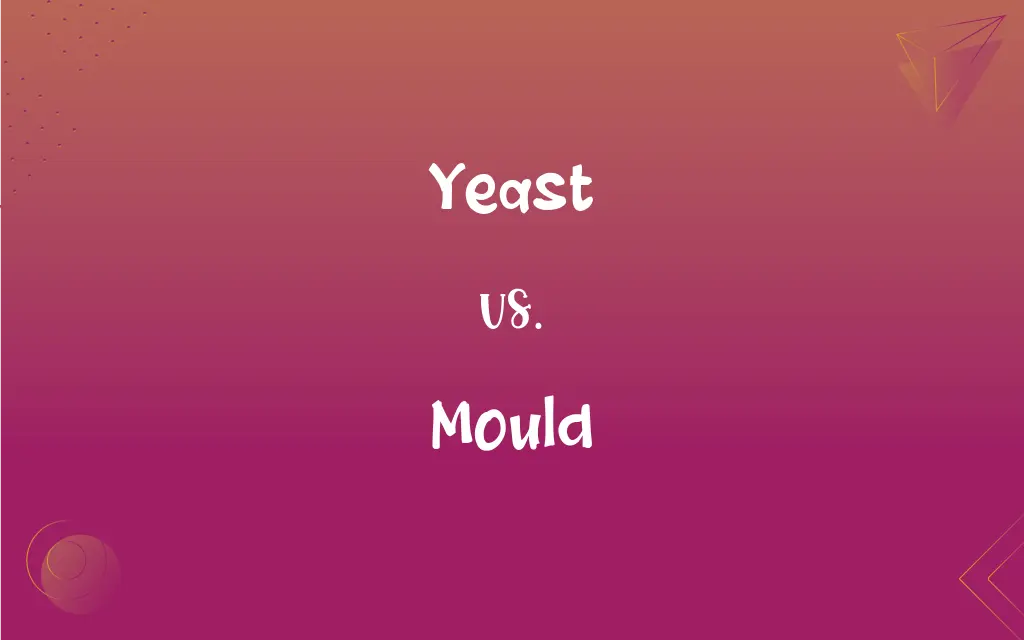Yeast vs. Mould: What's the Difference?
Edited by Aimie Carlson || By Harlon Moss || Published on February 11, 2024
Yeast is a single-celled fungus used in fermentation and baking, while mould is a multicellular fungus that grows in filaments and can cause decay.

Key Differences
Yeast is a single-celled microorganism, part of the fungi kingdom, often used in food production. Mould consists of multicellular filaments, visible as fuzzy growths, and can lead to food spoilage.
Yeast reproduces asexually, typically by budding, and is used in fermentation processes. Mould reproduces both sexually and asexually, forming spores that spread to new areas.
Yeast is integral to baking and brewing, converting sugars into alcohol and carbon dioxide. Mould is not commonly used in food production, except in certain cheeses, but can degrade organic material.
Some yeast strains are beneficial for health, used in probiotics and supplements. Mould can be harmful, producing allergens and toxins, although some are used in antibiotics and food.
Yeast plays a role in carbon cycle and fermentation in nature. Mould breaks down organic matter, essential for ecosystem nutrient recycling.
ADVERTISEMENT
Comparison Chart
Organism Type
Single-celled fungus
Multicellular fungus in filamentous form
Growth and Reproduction
Reproduces asexually, typically by budding
Reproduces sexually and asexually, forms spores
Usage in Food/Industry
Used in baking, brewing (fermentation)
Causes food spoilage, used in certain cheeses
Health Implications
Beneficial strains used in health products
Can be harmful, but some are used in medicine
Environmental Role
Involved in fermentation, carbon cycling
Decomposes organic matter, nutrient recycling
ADVERTISEMENT
Yeast and Mould Definitions
Yeast
A microorganism used in producing various food products and beverages.
Yeast is used to ferment grape juice into wine.
Mould
A multicellular fungus that grows in filaments and can cause decay.
Mould can spoil bread if it's left out too long.
Yeast
An organism that converts sugars into alcohol and carbon dioxide.
Yeast is essential in brewing beer.
Mould
A type of fungus that decomposes organic material.
Mould helps break down fallen leaves in forests.
Yeast
A type of fungus that can be beneficial for health.
Nutritional yeast is a popular dietary supplement.
Mould
An organism that reproduces by forming spores.
Mould spores can spread through the air.
Yeast
A single-celled fungus used in fermentation and baking.
Yeast is added to bread dough to make it rise.
Mould
Some moulds are used in producing certain foods and medicines.
Blue cheese gets its flavor from specific mould strains.
Yeast
Yeast plays a role in the carbon cycle through fermentation.
Yeast naturally ferments sugars in fruits.
Mould
Mould can be harmful, producing allergens and toxins.
Exposure to certain moulds can cause allergic reactions.
Yeast
Any of various unicellular fungi of the genus Saccharomyces, especially S. cerevisiae, reproducing asexually by budding or sexually through the production of ascospores and capable of fermenting carbohydrates.
Mould
Variant of mold1.
FAQs
Can yeast be used in brewing?
Yes, yeast is essential in brewing to ferment sugars into alcohol.
How does yeast reproduce?
Yeast typically reproduces asexually by budding.
What is mould?
A multicellular fungus that grows in filaments and can cause decay.
Is mould harmful to humans?
Some moulds can be harmful, producing allergens and toxins.
Can mould be beneficial?
Yes, some moulds are used in medicine and food production.
What are common places to find mould?
Mould commonly grows in damp, warm environments.
What is yeast?
A single-celled fungus used in fermentation and baking.
Can you see mould without a microscope?
Yes, mould growth is often visible as fuzzy or slimy patches.
Can yeast cause food spoilage?
Generally, yeast is used to enhance food rather than spoil it.
Why is mould on food a concern?
Mould on food can indicate spoilage and potential toxin production.
What precautions should be taken with mould?
Avoid inhaling or touching mould, and control moisture to prevent its growth.
Are there health benefits to consuming yeast?
Yes, certain yeast strains are used in probiotics and supplements.
What role does mould play in the environment?
Mould decomposes organic material, aiding in nutrient recycling.
How is yeast involved in the carbon cycle?
Yeast participates in the carbon cycle through fermentation processes.
How does mould reproduce?
Mould reproduces both sexually and asexually, forming spores.
Is yeast visible to the naked eye?
Individual yeast cells are microscopic and not visible to the naked eye.
Is yeast used in cheese making?
Typically, yeast is not used in cheese making; that's more the domain of moulds and bacteria.
Can mould be intentionally added to food?
Yes, certain moulds are intentionally added to foods like blue cheese.
What products are made using yeast?
Bread, beer, wine, and some health supplements are made using yeast.
Is it safe to consume products with yeast?
Yes, products containing yeast are generally safe for consumption.
About Author
Written by
Harlon MossHarlon is a seasoned quality moderator and accomplished content writer for Difference Wiki. An alumnus of the prestigious University of California, he earned his degree in Computer Science. Leveraging his academic background, Harlon brings a meticulous and informed perspective to his work, ensuring content accuracy and excellence.
Edited by
Aimie CarlsonAimie Carlson, holding a master's degree in English literature, is a fervent English language enthusiast. She lends her writing talents to Difference Wiki, a prominent website that specializes in comparisons, offering readers insightful analyses that both captivate and inform.































































